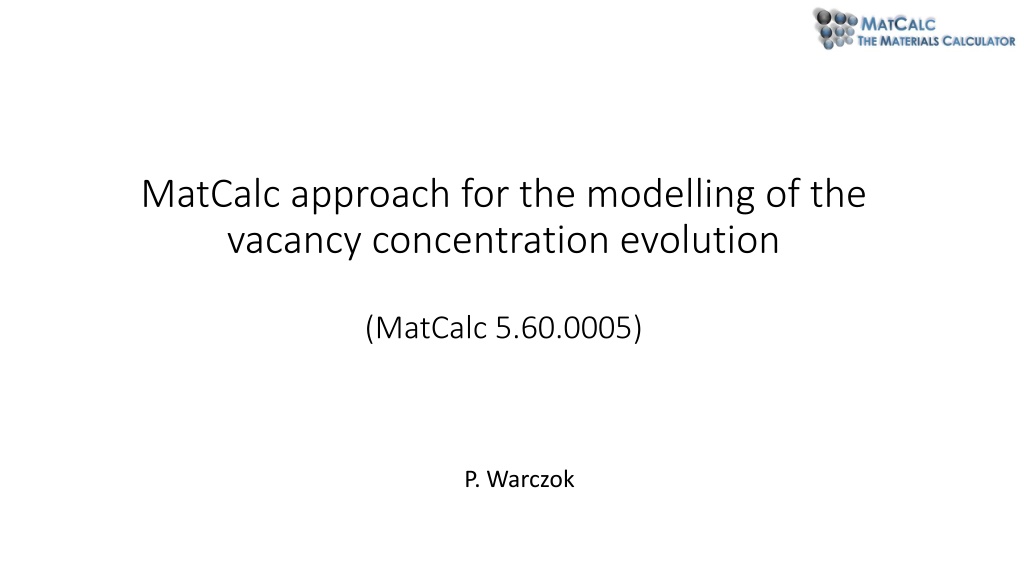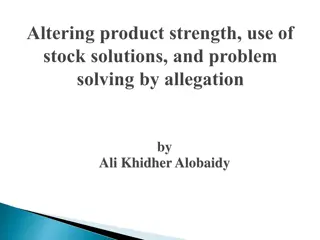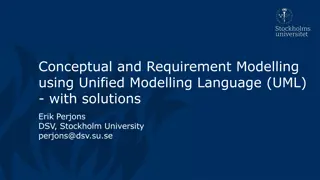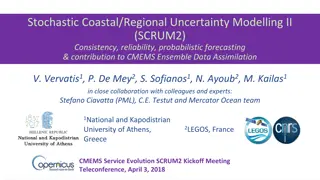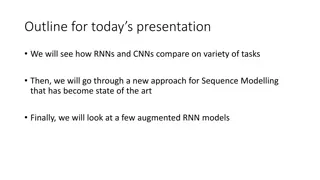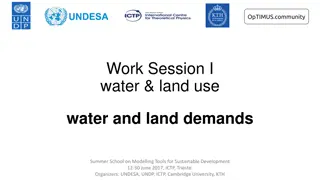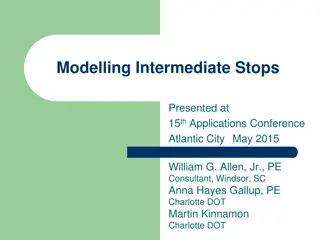Modelling Vacancy Concentration Evolution
Real materials contain imperfections known as vacancies, affecting properties like nucleation, precipitation kinetics, and diffusion. Equilibrium vacancy concentrations are influenced by thermodynamic principles, with changes possible through temperature adjustments, phase transformations, and material manipulation.
Download Presentation

Please find below an Image/Link to download the presentation.
The content on the website is provided AS IS for your information and personal use only. It may not be sold, licensed, or shared on other websites without obtaining consent from the author. Download presentation by click this link. If you encounter any issues during the download, it is possible that the publisher has removed the file from their server.
E N D
Presentation Transcript
MatCalc approach for the modelling of the vacancy concentration evolution (MatCalc 5.60.0005) P. Warczok
Outline Vacancy concentration What is it all about? Why do we care about? How does it evolve? Why does it (sometimes) take so long to evolve?
What is it all about? Real materials are not perfect crystals... http://www.tf.uni-kiel.de/matwis/amat/def_en/overview_main.html
What is it all about? Equilibrium vacancy concentration thermodynamics make them appear ? ???,??= ??? ??? ?? ?= ??? ? ???? ? ???
What is it all about? Equilibrium vacancy concentration thermodynamics make them appear ? ???,??= ??? ??? -Vacancy formation entropies are currently not ?? used in MatCalc -Vacancy formation enthalpies come from thermodynamic database. Feel free to change it, ?= ??? ? ???? ? ??? if you need it (Variables& function)
What is it all about? Equilibrium vacancy concentration thermodynamics make them appear
What is it all about? Equilibrium vacancy concentration thermodynamics make them appear
What is it all about? Equilibrium vacancy concentration thermodynamics make them appear
What is it all about? How to change the vacancy concentration? New equilibrium Change temperature Transform to a new phase Out of equilibrium Deform material Irradiate material
Why do we care? Nucleation Precipitation kinetics Vacancies Diffusion
Why do we care? Precipitation kinetics Vacancies Nucleation 16??3 ? = 22 ?~??? ? ?? ?? ? + ??? ?? ??? ???,?? ?? ?? ?? 3 ?? ?? ?? +9 1 ? ??= ???? ?? ?? 4?? ?? Chemical part Elastic part ?? - Vacancy contribution to driving force ?? ? Gas constant ? Temperature ???- Vacancy site fraction on subst. lattice (current) ???,?? - Vacancy site fraction on subst. lattice (equil.) ? - Critical nucleation energy ? Interfacial energy preciptate/matrix ??- Molar volume ? volumetric misfit of precipitate ? Poisson s ratio ?? - Young s modulus ? Nucleation rate
Why do we care? Precipitation kinetics Vacancies Nucleation 16??3 ? = 22 ?~??? ? ?? ?? ? + ??? ?? ??? ???,?? ?? ?? ?? 3 ?? ?? ?? +9 1 ? ??= ???? ?? ?? 4?? ?? Elastic part Chemical part - Generation/anihilation of the excess vacancies results in a strain of the matrix (last term) - Volumetric misfit of the precipitate may augment/decay the previous effect (second term)
Why do we care? 16??3 ??? ???,?? ? = ??= ???? 2 ?? 1 ?? ? +9 1 ? ?? 2 3 ?? ?? ??+ ??? ?? ?? 4????
Why do we care? 16??3 ? = 22 ?? ?? ? +9 1 ? ?? 3 ?? ??+ ??? ?? ?? ?? 4??
Why do we care? Precipitation kinetics Vacancies Diffusion ?? - Diffusion coefficent ?0,? - Pre-exponential factor ?? - Activation energy of subst. diff. http://www.doitpoms.ac.uk/tlplib/diffusion/diffusion_mechanism.php
Why do we care? Precipitation kinetics Vacancies Diffusion ??= ?0,???? ?? ??? ???,?? ?? http://www.doitpoms.ac.uk/tlplib/diffusion/diffusion_mechanism.php
Why do we care? Vacancies Diffusion ??= ?0,???? ?? ??? ???,?? ??
How does it evolve? Sources and sinks Source Sink Material Vacancy flow Equilibrium Generation rate at source = Anihilation rate at sink
How does it evolve? 3 models in MatCalc: Mean diffusion distance FSAK * model Vacancy generation during the deformation (with FSAK only!) * Fischer-Svoboda-Appel-Kozeschnik , Fischer et. al., Acta Mater. 59 (2011) 3463-3472
How does it evolve? Mean diffusion distance Dislocations are taken as a vacancy source/sink ? - Mean diffusion distance Default mean diffusion distance: ? Dislocation density ? = 10^ 0.5??? ? Evolution equation: ? - Constant ?? - Element subst. site fraction ??? ? = ? 1 ??? ? ? ??? ???,?? ???,?? ??? D = ???? ? ?
How does it evolve? Mean diffusion distance Dislocations are taken as a vacancy source/sink Default mean diffusion distance: ? = 10^ 0.5??? ? Evolution equation: ??? ? = ? 1 ??? ? ? ??? ???,?? ???,?? ??? D = ???? ? ?
How does it evolve? Mean diffusion distance Dislocations are taken as a vacancy source/sink Default mean diffusion distance Evolution equation ??? ? = ? 1 ??? ? ? ???,?? ??? ?
How does it evolve? FSAK: Generation/anihilation on dislocation jogs Evolution equation: ?? ? = 2?? ??? ???,?? ??? ???,?? ??? ?? ?? ? Diffusion correlation factor (0.75) ? ? Burger s vector ? Jog density ? = ????? ???? Jog fraction on dislocations
How does it evolve? FSAK: Generation/anihilation on dislocation jogs Evolution equation: ?? ? = 2?? ??? ???,?? ??? ???,?? ??? ?? ?? ? ? = ?????
How does it evolve? FSAK: Generation/anihilation on dislocation jogs Evolution equation: ?? ? = 2?? ??? ???,?? ??? ???,?? ??? ?? ?? ? ? = ?????
How does it evolve? FSAK: Generation/anihilation on grain boundaries Evolution equation: ?? ? = 15? ??? ???,?? ??? ???,?? ? 2 ??? ?? ? ? Radius of the spherical grain (0.5 * grain size)
How does it evolve? FSAK: Generation/anihilation on grain boundaries Evolution equation: ?? ? = 15? ??? ???,?? ??? ???,?? ? 2 ??? ?? ?
How does it evolve? FSAK: Generation/anihilation on Frank loops (test-phase?) Evolution equation: ?? ? = 4?2? ?2?? ?????? ??? ???,?? ??? ???,?? ?????? ?? ??? ?? 1 ? ??= ????,?? ?? - Effective loop energy ?? - Jog spacing on Frank loops (number of atoms) ??? - Frank loop radius (defined in the console) ????,?? - Jog fraction on Frank loops ??? - Frank loop density (defined in the console) ?? - Boltzmann constant
How does it evolve? FSAK: Generation/anihilation on Frank loops (test-phase?) Evolution equation: ?? ? ??? = 4?2? ?2?? ?????? ??? ???,?? ??? ???,?? ?????? ?? ?? ? 1 ??= ????,??
How does it evolve? Vacancy generation during the deformation Evolution equation: ??3 ??? ? = ?? ? ??? ??? ? ? 4? 1 ? ??? ? Constant ? Taylor factor ? Shear modulus ??? ???,??+ ??? ? - Strain rate
How does it evolve? Vacancy generation during the deformation Evolution equation ??3 ??? ? = ?? ? ??? ??? ? ? 4? 1 ? ???
Why does it take so long to evolve? The idea: Some vacancies are trapped in the material and do not proceed to the sinks. Equilibrium between the trapped an free-to-move vacancies Needed: The amount of traps The trapping strength Relation between the amounts of trapped and free vacancies
Why does it take so long to evolve? Possible traps Solute atoms Dislocations Grain- & subgrain boundaries Precipitate surface
Why does it take so long to evolve? Possible traps ?? - Number of bulk sites Trapping site Fraction of trapping sites ??? - Number of sites at grain boundary ?? Solute atoms 2? ???? - Number of sites at subgrain boundary Dislocations ???? ????? Grain boundary ??? - Dislocation core radius (5*10-19 m) ?????? Subgrain boundary ?? - mole fraction of component i 1 3 Precipitate surface ?? - Number of precipitates in class j 2 4???? ???? ????? ??- Radius of precipitates in class j ??? - Atomic volume
Why does it take so long to evolve? Trap strength : delta H ? = ??? ? ?? ? - Trapping enthalpy Trap range modifier: coordination number
Why does it take so long to evolve? The amount of traps Amount of lattice sites expressed by molar volumes ???? - Total number of lattice sites ??- Number of sites on which the vacancy is free to move ????= ??+ ?? ??- Number of sites on the vacancy traps ????,?= ?????? ?? - Number of i -sites (e.g. ??,??) ?? ???? =??,??? ??,? ?? - Molar volume (volume for ???? = 1) ??= ??,?- Volume of material containing 1 mole of i -sites ?? - Mole fraction of i -sites Svoboda J., Fischer F.D., Acta Mater. 60 (2012) 1211-1220
Why does it take so long to evolve? The amount of traps Amount of lattice sites expressed by molar volumes For clarity: ???? - Total number of lattice sites - ??,?is the volume of the material under consideration ??- Number of sites on which the vacancy is free to move needed to have the amount of 1 mole of i -sites in it. ????= ??+ ?? ??- Number of sites on which the vacancy is trapped The less i -sites in the material, the more of it is ????,?= ?????? ?? - Number of i -sites (e.g. ??,??) needed. ?? ???? =??,??? ??,? ?? - Molar volume (volume for ???? = 1) ??= ??,?- Volume of material containing 1 mole of i -sites - ??,?IS NOT the volume of 1 mole of i -sites! The ?? - Mole fraction of i -sites material does not consist of i -sites alone Svoboda J., Fischer F.D., Acta Mater. 60 (2012) 1211-1220
Why does it take so long to evolve? Vacancy balance ??,? ??,? ???,???= ???,???= ?????,?+ ?????,?= ??,?+??,????,?+ ??,?+??,????,? ???,? - Site fraction of vacancies on i -sites (= fraction of i -sites occupied by the vacancies) ??,? according fraction of trapping sites*coordination number ??,? assumed as ??,???(molar volume of system) Svoboda J., Fischer F.D., Acta Mater. 60 (2012) 1211-1220
Why does it take so long to evolve? Vacancy balance: ??,? ??,? ???,???= ???,???= ?????,?+ ?????,?= ??,?+??,????,?+ ??,?+??,????,? Minimization of free energy: ? ??? ? ? = ??? ? ?= ??? ? + ??? 1 ? ?? Combine these two above solve for ???,? and ???,? The immobile vacancies ?????,? ?????,? Svoboda J., Fischer F.D., Acta Mater. 60 (2012) 1211-1220
Examples Examples from MatCalc website (P2-1, P2-2) FSAK model Al-Cu system, 4.3 wt.% Cu Precipitates: TH_DP_GPB- (bulk), THETA_PRIME- (disl.), THETA_AL2CU- (disl.) Al-fcc domain
Examples Al-Cu system (Example P2-1), tempered at 200 C
Examples Al-Cu system (Example P2-1), tempered at 150 C
Examples Al-Cu system (Example P2-1), tempered at 100 C
Examples Al-Cu system (Example P2-1)
Examples Al-Cu system (Example P2-2), influence of cooling rate
Examples Al-Cu system (Example P2-2), influence of dislocation density
Examples System Al-Mg-Si Mg = 0,4 wt.%, Si = 1,1 wt.% Mg5Si6_B_DP-precipiate. Nucleates at bulk sites Al-fcc domain Trapping sites: Mg (2600 J/mol) and Si (3500 J/mol) solute atoms. FSAK model
Examples Variation of grain size (FSAK)
Examples Variation of grain size (FSAK)
Examples Variation of trapping enthalpy (FSAK)
